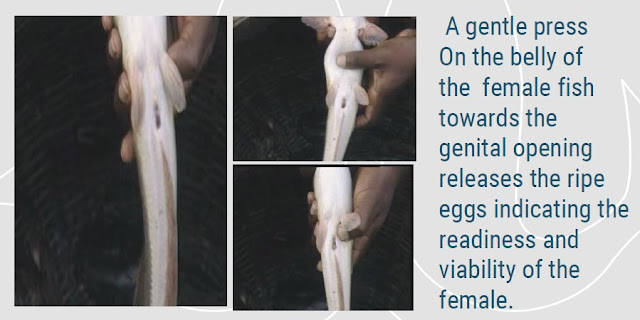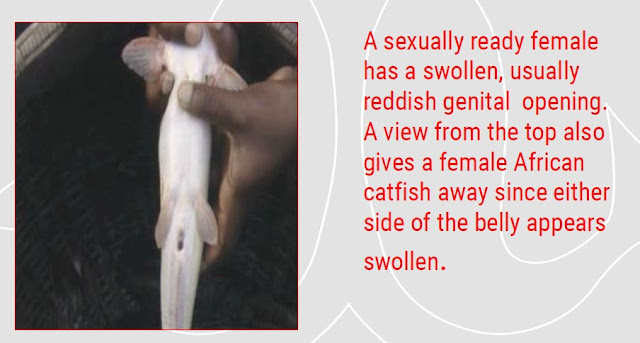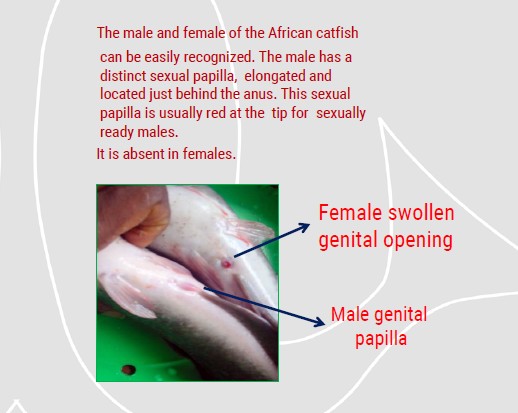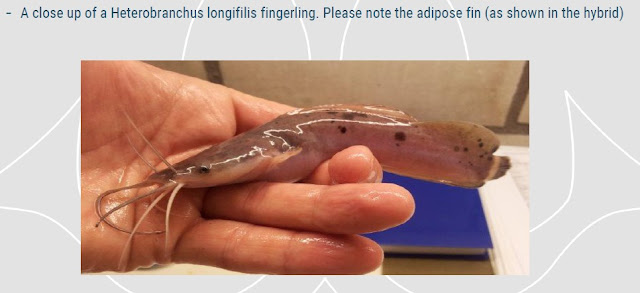Hatchery Set-up and Hatching Management
Hatchery Set-up and Hatching Management
Hatchery Set-up and Hatching Management is a free technique to help you make million in catfish production. Peruse through to gain some free Knowledge. Furthermore, Get a Complete e book on how to own, manage and make millions from Catfish Production. In like manner, Contact Us for a Good Business Plan and Feasibility Report on any Agribusiness Startup. Peruse through our Table of content below to see what we offer.
The first brood stock originated from the wild from the Central African Republic.
Commercial farming of this species started in 1985 in recirculation aquaculture systems (RAS). Much later catfish strains from Israel and the Republic of South Africa were introduced. These strains were crossed for the production of fingerlings and resulted in the currently cultured “Dutch strain” African catfish. On farmers level, brood stock selection is mostly done in a very uninformed way.
Another problem for the farmer producing African catfish fingerlings is to show his customer the benefit of an improved strain. Improvements in growth and feed conversion ratio of for example 5% are great achievements in the mind of a researcher, but for a farmer small differences are most probable not spotted without serious farm record-keeping. Practically, the market for African catfish fingerlings is first of all price driven. Next to this, hatcheries should focus on availability, size, uniformity and health status of the African catfish.
Meat quality and dress out percentage are very important parameters for the processing industry. Variation is noticed between the strains from different locations in Africa.
In the tropics the aspect of meat quality and dressing percentage are of less importance because the fish is consumed as a whole; no filets are taken from the fish and heads and intestines are not wasted.

The filet of Heteroclarias is white in comparison with the pink/reddish colour of Clarias gariepinus filets and contains 30% more fat than Clarias gariepinus filets, which improves the taste. The gonads of hybrids are almost absent and not active. For this reason the dressing percentage is relatively high compared to Clarias gariepinus. The Heteroclarias fish filet can be used as an alternative for white filets from marine fish species.

Fingerling production of Heteroclarias shows big differences in behaviour with the common African catfish. The Heteroclarias fingerlings show a wide variation in growth and severe cannibalism is noticed, especially when frequent grading is neglected. Next to this the Heteroclarias is easily stressed. After an age of 12 weeks, well graded fish show very equal growth and low mortality to the moment of harvesting at 1.4 kg.
In the tropics the Heteroclarias is considered superior over the Clarias gariepinus in growth in pond culture and is considered as better growing fish.
For a fingerling producer hybridisation has a major benefit. The hybrids are infertile and it is not possible for customers to continue breeding with those fish. The pure parent stock is kept on farm and is never shared with other farmers. The pure Heterobranchus longifillis strain matures at a age of 2 years, which is very late compared to Clarias gariepinus (1 year).
Preference is givem to a recirculation system connected to a water purification unit. The tanks, both fish tanks and tanks of the water purification unit, can be built of materials like glass fibre, polyethylene or concrete. The water purification unit consists of a sedimentation tank, a pump tank, a bio tower and a UV-system. The system should be placed in a confined area were the temperature can be controlled. The tanks should be equipped with good drains for easy and quick selection of the broodstock before reproduction. Next to this system a number of preparation-recovery tanks should be placed (around 300 liters).
Stocking: The number of brood stock needed depends on the success rate of the spawning. For example one female can be used for eight spawnings per year (in theory) providing 3.2 kg of eggs. This equals around 1.6 million eggs and with a minimal 10% survival till juvenile stage this results in a yearly production 160.000 African catfish juveniles.
Feed: African catfish broodstock should be fed with good quality feeds. Special feed should normally be used for broodstock, which has higher concentrations of proteins, fats, vitamins and certain aminoacids than normal grower feeds. The difference between broodstock feed and normal growout feed is the ingredients used in the diet. For African catfish broodstock feed the best quality fish meal is used, fat is provided only by fishoil (no vegetable oils are used) and micro nutrients are added. The feed has been tested mainly in salmonids and in these fishes it improves the fecundity in both sexes, the hatching rate and decreases the occurance of deformities in the fry (the addition of astaxanthine and Vitamine E to the feed prevents oxidative damage of young tissues by free radicals). The immune system of the broodstock is boosted by the addition of beta glucans (immunostimulants) in the feed. Researchers suspect that this also will be transmitted to the eggs. The broodstock could be fed about 4 times a day by hand.Even in the tropics I prefer to import expensive compound feed from a reliable factory in Europe instead of using locally produced and often unreliable feeds. I believe a good starting point is essential for a successful development of the offspring.
Life span of broodstock: In our hatchery we try to maximise the life span of the broodstock, since replacements are costly. Males can be used 1 (if the male is killed) to 4 times (if the operation procedure is used), before it is being replaced by new, younger males. Old males (above 4 years) tend to develop testis with sponge like tissue and it is containing watery sperm with a low concentration of sperm cells. Females can be used for a long period and stay in a better condition for a longer time, especially when the females are used maximum twice per year. Females reach a higher weight and size than males (max. 15 kg and 1.30 meters). Growing the next generation of broodstock should be done in a separate system.
Some farmers are using operation on the males. After tranquilizing the fish, a small incision is made in the belly of the fish and with a syringe with needle some sperm is taken out of the testis. Finally the incision in the belly is stitched using veterinary stitching material and the male is able to recover in 1 to 2 weeks. During this time the wound closes completely.
Unlike the sperm of mammals sperm of fish is not active, but will become active as soon as it is in the water. The sperm is active for less than a minute, so it has to find an egg quickly before all the energy has gone. This is the reason that during the process of sperm collection all materials, hands and the fish should be dry. Although these precautions are taken, the sperm can be activated accidentally. The sperm concentration of good males is more than a million per ml!
Cryo conservation of sperm has been done on an experimental scale and the method is quite successful. The problem of this method for farmers is that they have to be equipped with a laboratory and should have permanent availability of liquid nitrogen to keep the sperm preserved.
Adding certain fertilizing solutions during fertilization is reported as being very beneficial, because they are thought to extend the life of the sperm in order to improve the fertilization rate.
Artificial propagation of African catfish is a relatively simple procedure and many farmers are very skillful in doing it. Millions of larvae are hatched weekly in our country, Nigeria. However there still is a shortage of good quality fingerlings and juveniles. Reproduction of African catfish is following a certain procedure, but farming the larvae for 1 or 2 months to juvenile stage comes down to the capabilities of the individual farmer.
UNDERSTANDING THE BASICS FOR A SUCCESSFUL FISH BREEDING
- Key components needed are
- Water
- Land
- Power
- Feed
- Personnel
- Water Discharge point
- Market
CRITERIA TO CONSIDER IN SELECTING A SITE FOR FISH FARMING
- A flat Land
- Site Devoid of Rocks and Trees
- Site Close to A Fresh water Source, e.g River, Stream
- Furthermore, Site Close to ‘PHCN’ Power Lines
- Presence of Good, Abundant Underground water
STARTING SMALL, GETTING BIG ADOPTING A MODULAR DESIGN
- A Modular Design Consists of Sections
- That can be rearranged,
- Replaced, combined, or interchanged easily.
- Even if the funds are readily available, it is always
- Wise to start small.
- During the times of small,
- One will understand how best to grow big
Introduction to African Catfish hatchery set up and management African catfish (Clarias gariepinus)
In Europe, Clarias gariepinus was first introduced in the Netherlands in 1976.The first brood stock originated from the wild from the Central African Republic.
Commercial farming of this species started in 1985 in recirculation aquaculture systems (RAS). Much later catfish strains from Israel and the Republic of South Africa were introduced. These strains were crossed for the production of fingerlings and resulted in the currently cultured “Dutch strain” African catfish. On farmers level, brood stock selection is mostly done in a very uninformed way.
Another problem for the farmer producing African catfish fingerlings is to show his customer the benefit of an improved strain. Improvements in growth and feed conversion ratio of for example 5% are great achievements in the mind of a researcher, but for a farmer small differences are most probable not spotted without serious farm record-keeping. Practically, the market for African catfish fingerlings is first of all price driven. Next to this, hatcheries should focus on availability, size, uniformity and health status of the African catfish.
Selection of African catfish broodstock
The first broodstock came from the wild. In the Netherlands for example, wild African catfish was imported from Central Africa and the first generations the selection was based on growth. My personal opinion is that we were just performing selection of fish which were able to adapt to the intensive way of farming in warm water recirculation systems. In the Netherlands the strains were not kept separate and as a result the “Dutch African catfish” is a result of 3 strains.Meat quality and dress out percentage are very important parameters for the processing industry. Variation is noticed between the strains from different locations in Africa.
In the tropics the aspect of meat quality and dressing percentage are of less importance because the fish is consumed as a whole; no filets are taken from the fish and heads and intestines are not wasted.

Hybridization of African catfish
Within the family of Clariidae (Siluriformes) intergeneric hybrids were produced through interbreeding between species from the genera Heterobranchus and Clarias. A well-known intergeneric hybrid is a crossbred between the Heterobranchus longifillis female and Clarias gariepinus male, the so called “Hetero-clarias”. Due to rearranging of genetic material from both species in the offspring, the intergeneric hybrids show characteristics of both parental species.The filet of Heteroclarias is white in comparison with the pink/reddish colour of Clarias gariepinus filets and contains 30% more fat than Clarias gariepinus filets, which improves the taste. The gonads of hybrids are almost absent and not active. For this reason the dressing percentage is relatively high compared to Clarias gariepinus. The Heteroclarias fish filet can be used as an alternative for white filets from marine fish species.

Fingerling production of Heteroclarias shows big differences in behaviour with the common African catfish. The Heteroclarias fingerlings show a wide variation in growth and severe cannibalism is noticed, especially when frequent grading is neglected. Next to this the Heteroclarias is easily stressed. After an age of 12 weeks, well graded fish show very equal growth and low mortality to the moment of harvesting at 1.4 kg.
In the tropics the Heteroclarias is considered superior over the Clarias gariepinus in growth in pond culture and is considered as better growing fish.
For a fingerling producer hybridisation has a major benefit. The hybrids are infertile and it is not possible for customers to continue breeding with those fish. The pure parent stock is kept on farm and is never shared with other farmers. The pure Heterobranchus longifillis strain matures at a age of 2 years, which is very late compared to Clarias gariepinus (1 year).
African catfish broodstock section
System:Preference is givem to a recirculation system connected to a water purification unit. The tanks, both fish tanks and tanks of the water purification unit, can be built of materials like glass fibre, polyethylene or concrete. The water purification unit consists of a sedimentation tank, a pump tank, a bio tower and a UV-system. The system should be placed in a confined area were the temperature can be controlled. The tanks should be equipped with good drains for easy and quick selection of the broodstock before reproduction. Next to this system a number of preparation-recovery tanks should be placed (around 300 liters).
Stocking: The number of brood stock needed depends on the success rate of the spawning. For example one female can be used for eight spawnings per year (in theory) providing 3.2 kg of eggs. This equals around 1.6 million eggs and with a minimal 10% survival till juvenile stage this results in a yearly production 160.000 African catfish juveniles.
Feed: African catfish broodstock should be fed with good quality feeds. Special feed should normally be used for broodstock, which has higher concentrations of proteins, fats, vitamins and certain aminoacids than normal grower feeds. The difference between broodstock feed and normal growout feed is the ingredients used in the diet. For African catfish broodstock feed the best quality fish meal is used, fat is provided only by fishoil (no vegetable oils are used) and micro nutrients are added. The feed has been tested mainly in salmonids and in these fishes it improves the fecundity in both sexes, the hatching rate and decreases the occurance of deformities in the fry (the addition of astaxanthine and Vitamine E to the feed prevents oxidative damage of young tissues by free radicals). The immune system of the broodstock is boosted by the addition of beta glucans (immunostimulants) in the feed. Researchers suspect that this also will be transmitted to the eggs. The broodstock could be fed about 4 times a day by hand.Even in the tropics I prefer to import expensive compound feed from a reliable factory in Europe instead of using locally produced and often unreliable feeds. I believe a good starting point is essential for a successful development of the offspring.
Life span of broodstock: In our hatchery we try to maximise the life span of the broodstock, since replacements are costly. Males can be used 1 (if the male is killed) to 4 times (if the operation procedure is used), before it is being replaced by new, younger males. Old males (above 4 years) tend to develop testis with sponge like tissue and it is containing watery sperm with a low concentration of sperm cells. Females can be used for a long period and stay in a better condition for a longer time, especially when the females are used maximum twice per year. Females reach a higher weight and size than males (max. 15 kg and 1.30 meters). Growing the next generation of broodstock should be done in a separate system.
Sperm Harvesting
Male Clarias gariepinus do not release sperm after treatment with hormones like many other fish species. The males have ripe sperm all year round. The fish should be at least 1 year old to have ripe gonads. A lot of variation can be seen between males of the same age in ripeness and size of testis. In practice farmers sacrifice males in order to dissect the testis out of the abdomen. By making incisions in the testis tissue the sperm can be collected. As a consequence new male broodstock needs to be added to the broodstock population sacrificing the males is a big constraint on genetic programmes.Some farmers are using operation on the males. After tranquilizing the fish, a small incision is made in the belly of the fish and with a syringe with needle some sperm is taken out of the testis. Finally the incision in the belly is stitched using veterinary stitching material and the male is able to recover in 1 to 2 weeks. During this time the wound closes completely.
Unlike the sperm of mammals sperm of fish is not active, but will become active as soon as it is in the water. The sperm is active for less than a minute, so it has to find an egg quickly before all the energy has gone. This is the reason that during the process of sperm collection all materials, hands and the fish should be dry. Although these precautions are taken, the sperm can be activated accidentally. The sperm concentration of good males is more than a million per ml!
Cryo conservation of sperm has been done on an experimental scale and the method is quite successful. The problem of this method for farmers is that they have to be equipped with a laboratory and should have permanent availability of liquid nitrogen to keep the sperm preserved.
Fertilization of African catfish
The eggs and sperm are collected in a dry glass or porcelain bowl and a dry small glass or porcelain cup respectively. A simple but effective way of fertilization is to bring the eggs and sperm together in the egg collection bowl, mix it gently before adding water.Adding certain fertilizing solutions during fertilization is reported as being very beneficial, because they are thought to extend the life of the sperm in order to improve the fertilization rate.
Artificial propagation of African catfish is a relatively simple procedure and many farmers are very skillful in doing it. Millions of larvae are hatched weekly in our country, Nigeria. However there still is a shortage of good quality fingerlings and juveniles. Reproduction of African catfish is following a certain procedure, but farming the larvae for 1 or 2 months to juvenile stage comes down to the capabilities of the individual farmer.
Do you know you can actually save yourself off this stress?
Engage CHRIS FARM NIGERIA to give you a professional business plans and a feasibility that will suit your demand today.
For your Agribusiness, either production, processing, marketing of any Agro-industry, our feasibility studies or business plan are explicit.
Generally, our feasibility study and business plans are developed so well that it becomes irresistible when you show them to your investors or sponsors. It gives you a clear picture of what you are expected to see when you put the feasibility study or business plans into use. It also shows how much it will cost you to own your desired business, what your money can afford. The kinds of product you will need to minimize input in other to maximize output, and how much returns you will get at the end of each accounting year until your business break-even on its initial investment capital. This will give the intending business person or investor or farmer, a vivid idea on the possible benefit he or she stands to gain, when he or she starts doing the business. With that, the intending business person or investor or farmer will not need a soothsayer to make decision for him or her.
You can use this format in developing your own business Plans and feasibility Study
OUR TABLE OF CONTENT INCLUDE;
SECTION 1(Business plan section)
- SECTION I – EXECUTIVE SUMMARY
- NAME OF BUSINESS / COMPANY
- OFFICE & SITE LOCATION
- MOTIVATION
- MISSION STATEMENT
- SOCIAL/ECONOMIC VALUE
- PROJECT STATUS & START UP
- WHY PREPARE THIS BUSINESS PLAN?
- SECURITIES FOR THE PROPOSED LOAN
- REPAYMENT
- SECTION II – STUDY AREA
- STUDY AREA
- COMPANY OVERVIEW
- MANAGEMENT TEAM
- DEPARTMENTS IN THE COMPANY
- EXPERIENCE
- MANAGEMENT TEAM GAPS
- SECTION III – INDUSTRY ANALYSIS
- DEFINING YOUR INDUSTRY
- YOUR INDUSTRY SIZE GROWTH RATE AND SALES PROJECTIONS
- INDUSTRY STRUCTURE
- MARKET OVERVIEW
- MARKET SEGMENTATION
- RELEVANT MARKET SIZE
- KEY SUCCESS FACTORS
- LONG TERM PROSPECTIVE
- MARKET CHARACTERISTICS
- SAMPLING TECHNIQUE
- SECTION IV – CUSTOMER ANALYSIS
- TARGET CUSTOMERS
- CUSTOMER NEEDS
- MARKET NEEDS / SOCIAL PROBLEMS AND SOLUTIONS
- BUYERS BEHAVIOUR
- MARKET SHARE
- SALES FORECASTING
- SECTION V – COMPETITIVE ANALYSIS
- DIRECT COMPETITORS
- COMPETITIVE ADVANTAGES
- SECTION VI – MARKETING PLAN
- PRODUCTS & SERVICES
- FINISHED PRODUCTS
- PRODUCT QUALITY AND PRODUCTION QUANTITY
- PRODUCTION CAPACITY
- PRICING
- PROMOTIONS PLAN
- DISTRIBUTION PLAN
- SECTION VII – OPERATIONS PLAN
- GENERAL APPROACH TO PRODUCTION
- TECHNICAL ANALYSIS / PRODUCTION PROCESS
- EQUIPMENT
- PACKAGING REQUIREMENTS
- SECTION VIII – FINANCIAL PLAN
- REVENUE MODEL
- FINANCIAL ANALYSIS
- FINANCIAL ASSUMPTIONS
- FINANCE CHARGES
- FINANCIAL PROJECTIONS
- FUNDING REQUIREMENTS/USE OF FUNDS
- CRITICAL ASSUMPTIONS
SECTION 2(Feasibility study section)
- FINANCIAL MODELS
- SUMMARY OF PROJECT COST
- BUDGET OF FIXED ASSETS / CAPITAL EXPENSES / INVESTMENTS
- DEPRECIATION
- UTILITIES
- OPERATING EXPENSES (OPEX)
- TOTAL REQUIRED INVESTMENT OUTLAY (REQUIRED START-UP CAPITAL)
- FINANCING PLAN
- INSTALLED / AVAILABLE EQUIPMENT
- BREAK-EVEN ANALYSIS
- LOAN REPAYMENT SCHEDULE AND INTEREST PAID
- FORECAST OF PROFIT AND LOSS
- CASH FLOW
- BALANCE SHEET
- GENERAL ASSUMPTIONS (BREAK EVEN ANALYSIS)
- BUSINESS RATIOS - PROFITABILITY ANALYSIS
- CONCLUSION
- SECTION 3 – APPENDIX
Click other related clicks that may interest you below;
Acceptable feasibility study and business plan for bank loans
Feasibility study on piggery farming business Agbarho community, delta state
A PREPARED FEASIBILITY STUDY FOR CATFISH FARM IN NIGERIA
“How to own, manage, and make millions from catfish farmingbusiness” BEST SELLER
HOW TO OWN A MEGA FISH FARM BUSINESS IN NIGERIA
FLOATING FISH FEED PELLET MACHINE
TIPS ON BROILERS PRODUCTION AND ACTUAL VACCINATION –PROGRAMME AND TREATMENT
TIPS IN POULTRY MANAGEMENT
Sales of battery cage system in Nigeria
CASSAVA PROCESSING MACHINE
GRASS CUTTER/ CANE RAT PRODUCTION, BEST SELLER
How to handle and manage Snail farming
Rabbit Management
MANAGEMENT OF RABBITS, BEST SELLER
· NOTE; According to our policy, we are not “allowed / permitted” to disclose peoples business or written feasibility study, “to anyone”, irrespective of their personality.
· BUT, WE are permitted to display only executive summary.
· This is just a sample of our executive summary on poultry feasibility study and business plan, carried out in Rivers State.
· 1st sample;
These Feasibility study on poultry farming business (specializing on layers and boilers production), was conducted using projections, impressive publications, compounding interest/values, tables, graph, bar chart, pie chart, profits analysis and cash flow positions in other to give a clear picture of what is obtainable in that location, using eight plots of land, at Esemdiary village, Off Effurun Sapele Road, Okpe LGA of Delta state, Nigeria as a case study.
Esemdiary village is a community in Okpe Local Government Area of Delta State with coordinates 05°26’N 5°57’E, which also plays the host community to the Warri Airport, which is actually located at Osubi.
Okpe Local Government is a territory that used to be part of the original Okpe Kingdom, its headquarters is at Orerokpe, with a population of 128,398 people whose primary occupations include commercial farming, fishing, hunting, trading and gas exploration.
After carrying out the feasibility study on Esemdiary village, Off Effurun-Sapele Road, Okpe LGA of Delta state, Nigeria, it was discovered that, farming generally will do well both on crop and animal production.
HOW TO PLACE AN ORDER NOW?
- Bank Deposit
- Electronic Fund Transfer or western money transfer
- ATM cash Transfer
This payment method requires the customer to deposit, Electronic
Fund Transfer or ATM cash Transfer directly from his/her account into any of CHRIS FARM NIGERIA bank accounts.
If it is an E-Book, project materials, written project or written feasibility study, it will be sent to your immediately as soon as your transaction reflects in our account.
Please note; it will take ten working days to write (or prepare) a feasibility study or a project on your request.
Our bank details are on the website page, Just click on payment to get them
After placing your order, SMS your payment information (Manual title,
Name on teller, payment teller number, and your e-mail address)
E.g. catfish, Kelechi Bisi Amina,531796,allpurpose@yahoo.com
To +2348036925718 or +2348051270981 once I confirm your payment.
The material will be sent to your immediately! By e-mail Trust us 100% to do that.
Advantages of sending your request via email your e-book (electronic book) is downloadable from your e-mail box which allows you to read and print out this book
• Zero shipping costs.
• No wasting time, forget having to wait weeks for postal delivery.
• No risk of products lost in the mail or damaged
Thinking that we might live you after your purchase? Definitely no!
With the CBN policy in Nigeria via bank verification number (BVN), is almost impossible to steal your money from bank transfer or bank payment.
We assure you of maximum support when you need us. Please, do not hesitate to ask us for the way forward.
Get in touch with us today on our phone numbers or send us an email. We await your response……………………….
WRITTEN AND COMPILED BY CHRIS FARM NIGERIA
WEBSITE: www.chrisfarmnigeria.com
EMAIL: chrisfarmnigeria@gmail.com
PHONE: +234(803)-692-5718 or +234(805)-127-0981
LIKE US ON FACEBOOK: www.facebook.com/chrisfarmnigeria
FOLLOW US ON TWITTER: www.twitter.com/chrisfarm9ja
• A big thank you for your patronage in advance
Your Success, Is Our Optimum Desire
AT Chris farm Nigeria, We Deliver the Best Services…
Other services we render are displayed on our advert below;
ADVERTISEMENT
- We provide feasibility study/business plan for new and existing businesses
- We help you to recruit staff for your company, firm or organizations
- We help you in registering your company, firm or organizations
- Suppliers of any food stuffs
- Building contractor (especially building houses, constructions of ponds)
- Provides Architect for any design
- Help you in getting loans
- Sales of fingerlings, table size catfish, chicks, Grass-cutters, rabbits, snails, and many more
- Farm design
- Feed formulation for general livestock, including
- Floating/Sinking Fish feed
- Soybean oil processing, Teachings on how to test soybean cake,
- Teaching on how to remove the gummy and unpleasant smell of soybean oil
- Palm Oil/Palm nut cracking
- Fish Farming (Pond Construction and Fingerlings distribution)
- Poultry farm (plus marketing ideas)
- Rabbit farming
- Snail Farming
- Grass-cutter/cane rat Farming
- Commercial Crop Farming
- Handwork/Workshop Plan
- Pure Water Business
- Nylon production
- Professional Website design (cooperate and personal)
- Bulk SMS (plus re-seller website)
- Business Software Design
- Logo design plus company slogan
- Printing Press (Graphic design, lithography, banners, poster, handbills etc)
- Sales of battery cage for livestock farming all over Nigeria
- E-books on; Broilers farming, Layers farming, Grass-cutter farming, Rabbit farming, Pig farming, Catfish farming, and many more……
- How to own, manage, and make millions from catfish production (Most demanded)
- Projecting writing, Sales of written projects, and many more






Comments
Post a Comment